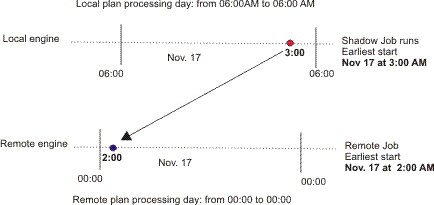How a distributed shadow job is bound
If the remote engine is an HCL Workload Automation master domain manager or backup master domain manager, the search for the remote job instance to bind is done in the preproduction plan. Distributed remote job instances, belonging to the JOBS or USERJOBS job streams, are not involved in the bind process. However, remote jobs that are moved to USERJOBS after binding continue to send status change notifications.
The matching interval, except for the closest preceding matching criteria that does not require interval calculation, is calculated on the remote engine using the settings specified in the distributed shadow job definition.
For example, when the sameDay matching criteria is specified, the day that is referred to is the day specified on the remote engine in terms of [startOfDay, startOfDay+23:59].
- For absolute interval matching criteria:
- The values hhmm, HHMM and,
optionally, d and D,
specified in the clause:
Boundary values are hhmm -6 days and HHMM +6 days.<dshadow:matching> <dshadow:absolute from="hhmm [+/-d day[s]]" to="HHMM [+/-D day[s]]"/> </dshadow:matching>The time zone used for the matching criteria is the time zone of the shadow job.
- For relative matching criteria:
- The shadow job scheduled time and the values [hh]hmm and [HH]HMM specified
in the clause:
Boundary values are +/-167:59 hours.<dshadow:matching> <dshadow:relative from="+/-[hh]hmm" to="+/-[HH]HMM"/> </dshadow:matching>
- Same scheduled date
- Within an absolute interval specifying as an offset: 1 day Before earliest start time.

The remote job instance to match is identified on the remote engine according to the rules stated for the external follows dependencies. For more details about external follows dependencies resolution criteria, see Managing external follows dependencies for jobs and job streams.
For more information about defining shadow jobs, see Job definition.